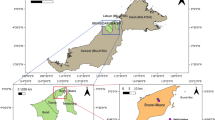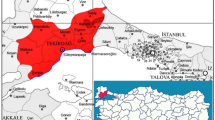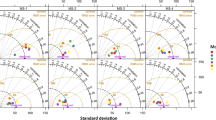Abstract
Many areas of Bangkok and its environs are currently blanketed with fine dust with dangerous levels of PM2.5. High levels of PM2.5 have a negative impact on human health. In this study, support vector regression, begged regression tree, random forest, gradient boosted models, neural networks, neural networks autoregressive, seasonal autoregressive moving average with exogenous covariates, k-nearest neighbor, Bayesian additive model, Prophet, and general additive models are used to anticipate PM2.5. The usefulness of adopting an ensemble model for forecasting is investigated. A thorough evaluation of standalone algorithms and ensemble techniques was performed using the root-mean-square error, mean absolute error, and Pearson correlation coefficient. According to the results, hybrid models are effective in the forecasting of PM2.5 concentrations.
Access this chapter
Tax calculation will be finalised at checkout
Purchases are for personal use only
Similar content being viewed by others
References
Jung, R., Hwang, F., Chen, T.: Incorporating long-term satellite-based aerosol optical depth, localized land use data, and meteorological variables to estimate ground-level PM 2.5 concentrations in Taiwan from 2005 to 2015. Environ. Pollut. 237(1), 1000–1010 (2018)
Health Effects Institute: State of Global Air 2020. Special Report. Boston, MA (2020)
Yiyi, W., et al.: Associations of daily mortality with short-term exposure to PM2.5 and its constituents in Shanghai, China. Chemosphere 233, 879–887 (2019)
Xing, Y.F., et al.: The impact of PM2.5 on the human respiratory system. J. Thorac. Dis. 8(1), E69–E74 (2016)
World Air Quality Index project. https://aqicn.org/city/bangkok/. Last accessed 25 Mar 2022
Catalano, M., et al.: Improving the prediction of air pollution peak episodes generated by urban transport networks. Environ. Sci. Policy. 60, 69–83 (2016)
Masood, A., Ahmad, K.: A model for particulate for Delhi based on machine learning approaches. Procedia. Comput. Sci. 167, 2101–2110 (2020)
Suleiman, A., et al.: Applying machine learning methods in managing urban concentrations of traffic-related particulate matter (PM10 and PM2.5). Atmos. Pollut. Res. 10(1), 134–144 (2019)
Doreswamy, et al.: Forecasting air pollution particulate matter (PM2.5) using machine learning regression models. Procedia. Comput. Sci. 171, 2057–2066 (2020)
Sharma, N., et al.: Forecasting air pollution load in Delhi using data analysis tools. Procedia. Comput. Sci. 132, 1077–1085 (2018)
Qiao, W., et al.: The forecasting of PM2.5 using a hybrid model based on wavelet transform and an improved deep learning algorithm. IEEE Access 7, 142814–142825 (2019)
Biancofiore, F.: Recursive neural network model for analysis and forecast of PM10 and PM2.5. Atmos. Pollut. Res. 8, 652–659 (2017)
Mahajan, S.: An empirical study of PM2.5 forecasting using neural network. In: 2017 IEEE SmartWorld, Ubiquitous Intelligence & Computing, Advanced & Trusted Computed, Scalable Computing & Communications, Cloud & Big Data Computing, Internet of People and Smart City Innovation, pp. 1–7. IEEE, San Francisco, USA (2017)
Ejohwomu, O.A., et al.: Modelling and forecasting temporal PM2.5 concentration using ensemble machine learning methods. Buildings 12(1), 46 (2022)
Gupta, P., et al.: Machine learning algorithm for estimating surface PM2.5 in Thailand, Aerosol Air Qual. Res. 21(11), 210105 (2021)
Buuren, S.: Karin Groothuis-Oudshoorn: mice: multivariate imputation by chained equations in R. J. Stat. Softw. 45(3), 1–67 (2011)
Box, G.E.P., et al.: Time series analysis: forecasting and control, 4th edn. John Wiley & Sons Inc., Hoboken, New Jersey (2008)
Hyndman, R.J., Khandakar, Y.: Automatic time series forecasting: the forecast package for R. J. Stat. Softw. 27(3), 1–22 (2008)
Taylor, S.J., Letham, B.: Forecasting at scale. Am. Stat. 72(1), 37–45 (2018)
Breiman, L., et al.: Classification and Regression Trees, 1st edn. Chapman and Hall/CRC, Boca Raton (1984)
Kroese, D.P., et al.: Data Science and Machine Learning: Mathematical and Statistical Methods, 1st edn. Chapman and Hall/CRC, Boca Raton (2020)
Hothorn, T., et al.: Unbiased recursive partitioning: a conditional inference framework. J. Comput. Graph. Stat. 15(3), 651–674 (2006)
Chen, T.Q., Guestrin, C.: XGBoost: a scalable tree boosting system. https://arxiv.org/abs/1603.02754. Last accessed 17 Apr 2022
Chipman, H.A., et al.: BART: Bayesian additive regression trees. Ann. Appl. Stat. 4(1), 266–298 (2010)
Vapnik, V., et al.: Support vector method for function approximation, regression estimation, and signal processing. Adv. Neural Inf. Process. Syst. 9, 281–287 (1997)
Author information
Authors and Affiliations
Corresponding author
Editor information
Editors and Affiliations
Rights and permissions
Copyright information
© 2022 The Author(s), under exclusive license to Springer Nature Switzerland AG
About this paper
Cite this paper
Srisuradetchai, P., Panichkitkosolkul, W. (2022). Using Ensemble Machine Learning Methods to Forecast Particulate Matter (PM2.5) in Bangkok, Thailand. In: Surinta, O., Kam Fung Yuen, K. (eds) Multi-disciplinary Trends in Artificial Intelligence. MIWAI 2022. Lecture Notes in Computer Science(), vol 13651. Springer, Cham. https://doi.org/10.1007/978-3-031-20992-5_18
Download citation
DOI: https://doi.org/10.1007/978-3-031-20992-5_18
Published:
Publisher Name: Springer, Cham
Print ISBN: 978-3-031-20991-8
Online ISBN: 978-3-031-20992-5
eBook Packages: Computer ScienceComputer Science (R0)




